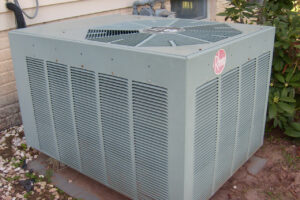Written on: June 23, 2020

(Photo/https://www.publicdomainpictures.net)
While there are several things to consider when deciding which AC unit to buy, perhaps the most important question you may be asking yourself: What size AC unit do I need?
Not only do you want to avoid wasting money on the wrong air conditioner, but you also don’t want to throw your money out the window each month, as the unnecessarily large AC unit burns up your energy bill.
Likewise, you don’t want to buy a unit that’s too small for your house, which means it will be running all the time to try and cool you down, eventually leading you to buy a second unit.
Thankfully, you can avoid guessing games and calculate the right size AC unit your house needs.
There are several things you will need to consider, all of which will affect the size of the AC unit you will need for your house:
To come up with a ballpark, the three most important numbers you need to know:
Tonnage actually has nothing to do with weight. A ton refers to the AC unit’s capacity to cool the air, in other words, how much heat the unit can remove in one hour.
That capacity is measured in BTUs or British Thermal Units. Why BTU? A long time ago, they determined it takes 286,000 BTU to completely melt one ton of ice in a 24-hour period. HVAC experts eventually divided that number by 24 hours and came up with 12,000 BTU/1-ton AC capacity.
Using that measurement, a two-ton AC unit will remove 24,000 BTUs, while a three-ton AC unit will remove 36,000 BTUs. Therefore, the more tonnage the AC unit is rated for, the more air it can cool down.
To get a rough estimate of the tonnage you will need from your AC unit, use the following calculation:
Square footage of your home x 25 (estimated energy to cool one square foot is 25 BTU) / 12,000 –1 = AC Unit Tonnage
For example, the calculations for a 1,200-square-foot home:
(1,200 x 25) / 12,000 –1 = 1.5 Tons
You would need a 1.5 ton AC unit for your house.
If you live in a drier or hotter region, don’t subtract 1.
For example, the calculations for a 1,200-square-foot home located in New Mexico:
(1,200 x 25) / 12,000 = 2.5 Tons
You would need a 2.5 ton AC unit for your house.
This table should give you an idea of what size AC unit you need, depending on the square footage of your house (located in a temperate climate region):
| Square Footage | BTUs per hour | AC Unit Tonnage |
| 450 to 550 | 12,000 | 1 Ton |
| 550 to 700 | 14,000 | 1.5 Tons |
| 700 to 1,000 | 18,000 | 1.5 Tons |
| 1,000 to 1,200 | 21,000 | 2 Tons |
| 1,200 to 1,400 | 23,000 | 2 Tons |
| 1,400 to 1,500 | 24,000 | 2 Tons |
| 1,500 to 2,000 | 30,000 | 2.5 Tons |
| 2,000 to 2,500 | 34,000 | 3 Ton |
Of course, all the other factors we previously discussed will also affect the unit you ultimately end up purchasing:
There are commonly two different types of air conditioning systems you can install in your home: a packaged unit or a split system.
The packaged unit air conditioner is the one most commonly associated with a central air system. With this system, the evaporator, condenser, and compressor are placed in one single cabinet. This cabinet is most often located on a concrete slab outside or on the roof. This type of packaged air conditioner usually includes electric heating coils or a natural gas furnace. This removes the need for an entirely separate furnace.
This type of system is most often used in homes that already have a furnace but no air conditioner installed. It’s the most cost-effective way to install air conditioning in a house.
With a split-system central air conditioning unit, an outdoor cabinet holds the condenser and compressor. An indoor cabinet holds the evaporator. This indoor cabinet may also hold the furnace.
While it’s fairly simple to come up with a rough estimate on the right size AC unit you will need for your house, ultimately, it’s safer and will save you money in the long run, if you work with an HVAC expert to determine the proper size.
Installing central air can cost you between $3,779 and $7,429, according to HomeAdvisor.com. So you want to make sure you’re buying the right unit the first time.
Getting the right unit will ensure your cooling system can perform efficiently for years, especially with regular maintenance.